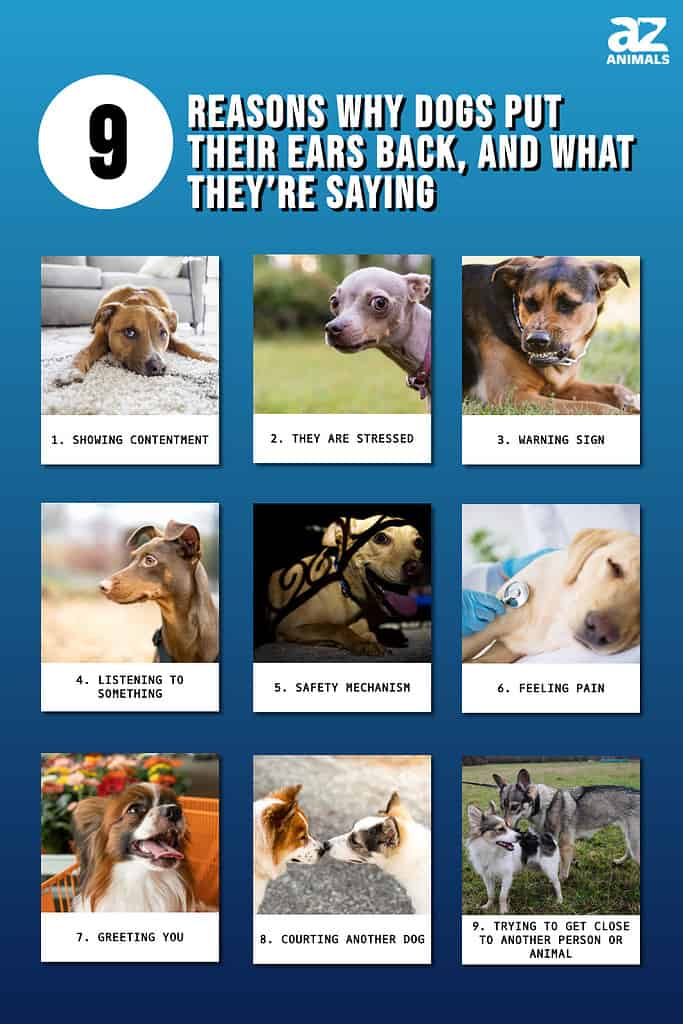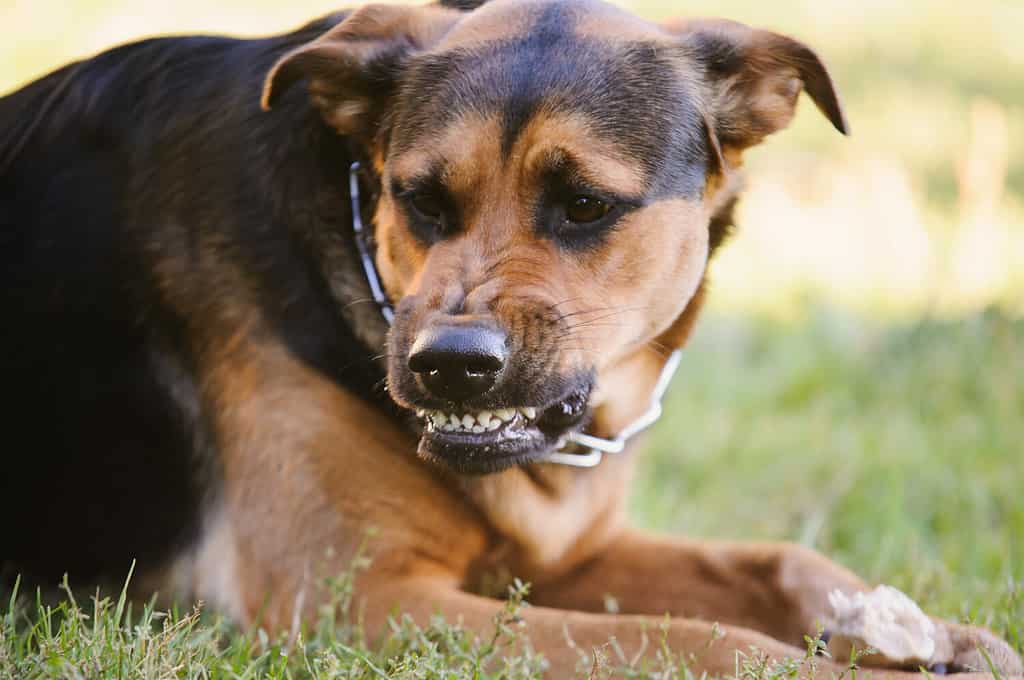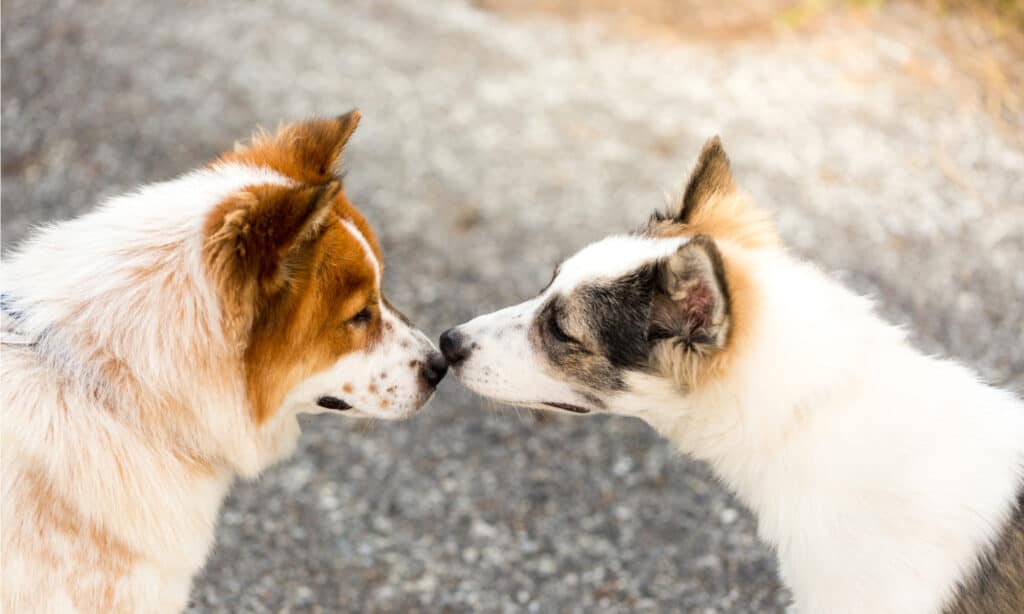Animal behavioralists and owners alike have always looked for ways to communicate with their pets. It would be nice to know what your dog is trying to tell you or what they are currently feeling. You can do that by understanding their body language.
Have you ever wondered–why do dogs put their ears back? Dogs put their ears back for several reasons. They have been using this to display their emotion for decades. The meaning of each ear gesture is understood within their species. But as man’s best friend, dogs can use this to try and communicate with you too.

Most canines can perk, flatten, or swivel their ears. However, dogs with cropped ears can have a limited way of moving their ears to communicate.
When you are trying to determine what your dog is thinking or feeling, you have to take some time to observe other signals too. Do not just look at the ears or eyes. Consider their overall stance and the sounds they make. Try to pay attention to what is happening around your dog to understand their expressions.
So why do dogs put their ears back? Here are some reasons why dogs pull back their ears and what that can mean.
1. Showing Contentment

A dog’s ears pinned back may simply show that it is relaxed.
©N K/Shutterstock.com
When your dog is relaxed, they let their ears hang in a neutral position. Canine breeds like German Shepherds have pointy ears, so their relaxed position can look alert compared to other dogs. They can flatten their ears or fold them back if they are content.
Some can express tension on their face when they are content, which pulls the ears back. Not all dogs are like that, though.
Imagine your dog lying down after spending the day running around the park or beach. They will be panting excessively and have squinty eyes and pulled-back ears.
If your dog has a relaxed body, holds its tail high, and has just engaged in an enjoyable activity while having its ears back, you can be fairly sure they are content.
And that is what you have to do. Look at the big picture and each element of your dog. Check the surroundings and what is happening. All of that combined shows you what they are feeling.
2. They Are Stressed

A dog may signal it is stressed by folding its ears back.
©iStock.com/koldunova
On the opposite spectrum of things, folding their ears back can signal being stressed or anxious. It is a sign of distress. The further back it folds, the higher their anxiety level would be. If it is completely flat on their head, it could mean they are very anxious.
If they are anxious, you will notice that the whites of their eyes are showing. That is called whale eyes and is also a sign of stress. You may also find that their body is tense.
The next time you get angry at your little pup for something they did, notice how their body language reacts. You most likely notice appeasement in how they are acting. But that is not because of feeling guilty, but rather, the dog is intimidated by you. That is why they would try to make themselves look as small as possible.
If you notice this, be careful. A scared and anxious dog will be prone to snap at and bite if feeling threatened in this state.
If you cannot find the source of their stress, you can use products like an anxiety jacket or dog towel if they are always stressed. Natural calming aids are also available to help. If these do not work, you should consult your vet.
3. Warning Sign

When a dog is about to bite, it may tuck its ears back.
©Art_man/Shutterstock.com
Folding ears backward can also be a warning sign from your dog that they are about to take a bite. That is especially true if the ears are flat on their head. That usually coincides with fearful or aggressive body language.
Other signs demonstrating that your dog is about to bite are the sounds they make. Growling and snarling are clear signs of the intent to defend themselves violently if needed. Curled lips are another sign of aggression to look out for.
While it is worrying to see, you should not punish your dog for snarling or growling. Doing so will teach them that giving warning signs can get them into trouble. Next time they feel fear or discomfort, they may hide the signs and immediately bite instead. Allow them to express their feelings, even negative ones.
Instead of punishment to get them to stop growling or snarling, try to find out why they are acting that way. They could be sensing something out of the ordinary, like getting crowded by new people.
It is important to consider the dog’s surroundings and the environment when they show signs of what they feel.
4. Listening to Something

A dog that is listening may pin its ears back, or its ears may perk up.
©Mary Swift/Shutterstock.com
Dogs can swivel or pull their ears back because they are trying to focus their listening. Why do dogs put their ears back when they are listening? Unlike people, they can focus their hearing by moving their ears instead of their heads. They will swivel their ears toward the sound they are concentrating on or draw them back if the sound is coming from behind them.
When listening for something, the dog will be in an alerted stance. They will stand still in a single position while trying to focus on the sound with tails hanging down at a normal position.
Depending on the location of the sound, they can even move their ears forward.
You can notice this by bringing your dog outside with you to the garden, for example. Have another family member stay inside the house and call for your dog. Ears will instantly perk up, and the dog will look alert as he concentrates on the call.
5. Safety Mechanism

A dog with its ears back may be stressed or frightened.
©Patrick H/Shutterstock.com
Another reason why dogs would pull back their ears is for protection. It is a safety mechanism during stressful or threatening situations. They do this to decrease the points of contact a potential attacker can target.
It is a natural reaction to threats, even in humans. When we see danger, we try to make ourselves as small as possible, such as sitting or lying in the fetal position where our legs, hands, and body are all pulled together. Similar behavior can be observed in canines when they put their tail between their legs, bend their knees, pull their ears back, and run away from a threat.
Ears are thin. A set of teeth from another animal can cause severe damage to it. Because hearing is one of the more important senses they rely on, they want to protect them as much as possible. That is why they pull them back when in a dangerous situation.
6. Feeling Pain

A dog in pain may pin its ears back as a safety mechanism.
©didesign021/Shutterstock.com
If your dog is injured or in pain, they can pull their ears back to signify that. They do this for fear of getting hurt further. As mentioned, it is a safety mechanism for them. If they are in pain, the dog will not want their ears to become the next target.
Dog ears are very vascular. If they scratch too hard, there is a chance they could burst a blood vessel inside the ear flap. In that case, the flap will get filled with blood and start looking swollen, puffy, or pillowy. You need to bring your dog to the vet if that is the case.
In some rare cases, your dog can pull their ears back because of a nasty ear infection. If you do not find any other reason why they are in this position, it may be a good idea to go to the vet or seek assistance. An ear infection can cause further damage if left untreated.
And if your dog is in constant pain, they will most likely snap at you and bite. Have them checked by a vet to be sure.
You can use eardrops to decrease the itchy feeling they get. That reduces the chance of them damaging or hurting their own ears when scratching.
7. Greeting You

A dog that is happy to see you may pin its ears back.
©Roman Mykhalchuk/iStock via Getty Images
One of the greatest sights in the world is seeing how excited your dog is when you come home from work or any other place. They typically fold their ears back and contort their body into a U-shape while wagging their tail. Other dogs would run to you and lick your face while holding their ears back.
Having ears back is often a welcoming gesture from your dog. They are trying to get close to you without looking threatening. It is a friendly demonstration accompanied by a happy-looking face and loose body language. They feel comfortable, and they would try to make you feel the same way with them.
8. Courting Another Dog

©Meesiri/Shutterstock.com
In as much as they use folded ears to greet you, your dog can use the same gesture when they are interested in the opposite sex. They have different courting rituals, and folding their ears back is a sign of submission. It can also be a sign of acceptance of the other.
It is also advisable to not disturb your dog when he is getting to know another of their own species as it can be seen as an aggressive behavior and your dog can react in a negative manner.
9. Trying to Get Close to Another Person or Animal

Two dogs gently sniffing and greeting each other in a park. A dog may pin its ears back in a situation like this.
©Marek Rybar/Shutterstock.com
If your dog is curious about another living being, like another person or even another animal, they can have their ears folded back as they approach. It follows the idea that they want to look like they have no intention to harm as they get closer.
Folded ears are commonly accompanied by a curious face and a caring demeanor when trying to get close. While they want to get close, they are unsure what can happen next, leading to being cautious.
Conclusion
The ear is a fascinating part of your dog. It gives you one of the best signals of what your dog is feeling, especially for some breeds that have very articulate ears.
Just be careful about context. You may read it as appeasement, but it could be that your dog is stressed. If you make a mistake, it could stress your dog more than they already are. It can even lead to getting bitten.
Examine everything. The ears are a good start, but it does not tell the entire story. Outside factors play a huge role in this, so be aware of what is happening around your dog to understand better what they feel.
Every dog is different and has its own characteristics. You have to build a good relationship with that. And to do that, communication plays an important role.
What Are Some Other Ways Your Dog Communicates?
A dog’s behavior tells you a lot about its feelings. If a dog is sad, it can a) lose interest in playing or walking; b) lose its appetite; c) demonstrate destructive behavior; d) become clingy or needy; e) become withdrawn; f) become irritable; g) have more frequent accidents.
If your dog is happy, you will see a) good behavior; b) sufficient sleep; c) relaxed eyes; d) a healthy appetite; e) a wagging tail; f) smiles.
Get to know your dog, observe his behavioral traits, and be aware of the “tells” that let you know how your dog is feeling, physically and emotionally.
The photo featured at the top of this post is © Seregraff/Shutterstock.com
Ready to discover the top 10 cutest dog breeds in the entire world?
How about the fastest dogs, the largest dogs and those that are -- quite frankly -- just the kindest dogs on the planet? Each day, AZ Animals sends out lists just like this to our thousands of email subscribers. And the best part? It's FREE. Join today by entering your email below.
Thank you for reading! Have some feedback for us? Contact the AZ Animals editorial team.






